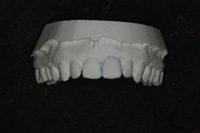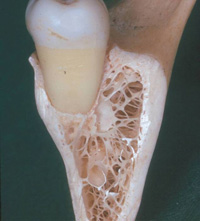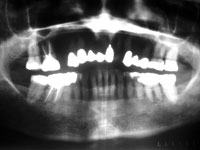This piece is short and sweet, just like my inspiration was for writing it. Allow me to explain…
A few weeks after I had received the topic for this article, which coincidently was about the same time that I was desperately searching for a different angle from which to discuss one of the standard “same old, same olds” of practice management, I met Pamela. I was speaking at New York University’s School of Dentistry to kick off the practice management program for the fourth-year students in hopes of preparing them for the “real world” of dentistry as we know it. I wanted to be sure to make a good first impression and be well prepared by getting there early. As it turned out, not only did I get there early, but I was given a valuable lesson on just how you are supposed to obtain treatment acceptance from your patients, as taught to me by a 12-year-old.
Arriving at the school, I was quick to locate the lecture hall where I would be presenting. I peered in the small window on the door, and as luck would have it, the huge, theatre-style room was empty, or so I thought. Walking in, I was a bit surprised to notice a woman and a young girl sitting quietly in the front row of seats just inside the door to my right. I politely smiled and said hello, thinking that this woman must be a student who had arrived early and needed to bring her daughter for some reason, when a small voice broke my train of thought.
I looked up to see the little girl smiling at me. “Are you the teacher?”
“No, I am just the guest speaker, but I will be teaching the class today,” I said.
“My name is Pamela. What’s your name?”
“I’m Mike,” I said with a smile at the little girl’s persistence.
“Hi Mike,” she said. “Guess how old I am?” she continued, much to the amusement of her mother as well.
Thinking this was an obviously loaded question, I answered as diplomatically as possible. “I would guess that you are at least 8, but you could look very young for your age,” I said.
“I’m 12,” she said, now smiling even more.
“Pamela, what are you doing here?” I asked.
“I’m waiting to see the orthodontist with my mom,” she said. At that moment I realized that the school clinic was across the hall, and they had arrived early as well. The playful interrogation continued as I attempted to write my agenda on the chalkboard.
“So, what are you teaching today, Mike?” Pamela asked.
“I’m teaching dental students case presentation and treatment acceptance,” I said, half hoping that it would be a complicated enough answer to get Pamela disinterested and get me off the hot-seat so I could continue to get ready for my presentation. No such luck.
“What’s that about?” she questioned.
“It’s teaching the students about how to get their patients to accept what they are telling them about the treatment they need, and then getting their patients to pay for it,” I replied.
“Oh, I know how you do that,” she said quite matter-of-factly.
“Really? Well, why don’t you tell me how you would do it so I can learn a few tips from you to share with the class later on,” I said, as Pamela’s mom and I shared a laugh.
“Okay, well it’s quite simple you see. You just have the patient sit in the chair, tell them to open their mouth, tell them what’s wrong with their teeth, and then make sure they pay you and schedule an appointment…That’s it,” she said with another big smile.
I don’t know if it was noticeable that my mouth had dropped open a bit in genuine amazement at what I had just heard, but I can tell you her mom was sure proud, and really getting a kick out of my loss for words as I paused to collect myself for a response.
“That’s very good Pamela,” I said. “Maybe you should stay and help me teach the class if it’s okay with your mom.” But Pamela’s mom was already collecting their things to get to the clinic for their orthodontist appointment. Despite her brief pleading to stay, Pamela knew she had to go as well.
“Goodbye Mike,” she said with another big smile. “It was nice meeting you.”
“It was nice meeting you too, Pamela, and thanks for your help.” And with that, she was off to the clinic, and I was left to consider the succinct yet insightful words of wisdom from a little girl who was anonymous to the dental profession just a few minutes ago. Unbeknownst to her, Pamela had prophetically hit upon several core principles of treatment acceptance in her own innocent way. Though a little direct and somewhat simplistic, she covered what I often refer to in my program as the “Five C’s” of case presentation and treatment acceptance. Here they are in brief. Consider them the intangible fundamentals that if applied to whatever system you use, will help maximize treatment acceptance.
(1) Confront. Pamela displayed her willingness to come face to face with a patient without avoiding what needed to be said and done in order to get the patient to accept what she was saying. Fear, failure, and the repeated experience of rejection had not jaded her ability simply to present from a position of power with her own self-interests and insecurities out of the way. Simply put, if you are able to confront presenting treatment and getting it accepted, you will have more accepted treatment; but if you cannot confront, you won’t have large retorative cases, cosmetics, preventative treatment, and programs for managing soft tissue, for example.
(2) Certainty. There was no doubt and there was absolute confidence in Pamela’s approach. She knew what to say and what to do, and you clearly felt it when she was delivering her message. So the lesson here is…know your stuff. Be prepared and confident with a solid system for educating and converting patients into all desired and/or necessary treatment without wavering or backing off.
(3) Communication. Pamela definitely wasn’t timid in her approach to relaying her thoughts and ideas. She expressed herself well and professionally while at the same time keeping it simple and direct. Of course, you want the communication to be more 2-way and interactive in contrast to the matter-of-fact “lay down the way it’s going to be” approach that Pamela took (which, by the way, doesn’t generate the best acceptance and compliance rate). Although Pamela’s approach was a bit abrupt, she was essentially getting the point across conveying intention, power, and the desire to create an understanding for the patient.
(4) Control. There was clear, positive direction being given in Pamela’s presentation. She was in charge and directing the patient from start to finish. Though it may have seemed a bit dictatorial in nature, Pamela’s approach nearly covered how the entire flow of treatment presentation and acceptance should go, from start to finish, give or take a few refinements in presentation and team support. Control equals compliance, adherence to office policy, and income as a result. Control is not force and effort; it is simply positive direction given to your patients and team.
(5) Commitment. In the end, Pamela’s approach did not forgo getting a commitment from the patient. A commitment of both time and money was secured at the end of her presentation to ensure the patient would get the recommended treatment. She in essence made sure that her patient was closed on the case rather than leaving it to chance that it would occur at some later date.
As I jotted these ideas down while the first students began to arrive for my presentation, I admired again how a sweet, little 12-year-old girl without any script or formal training in dentistry or practice management instinctively seemed to know how you needed to go about getting a patient to accept treatment. It was at this moment, as if she knew I was thinking about her, that I heard her voice again.
“Hey Mike,” she said, poking her head in the door as her mom was trying to pull her away, “let me know if you need any more help, and I’ll come see you again the next time you are here.”
Ah, out of the mouths of babes…
Mr. Massotto is the founder and CEO of Staff Driven Practices. After 10 years of business consulting success, Mr. Massotto used his extensive expertise in business and personal development to master their application in the dental field. ABC, FOX, CNN News, and Dentistry Today have nationally recognized him. Since 1997 his unique approach to dental practice development has helped create effortless and fulfilling lives for dentists and their teams. Mr. Massotto is the author of the book The 25 Surefire Ways to Destroy Your Dental Practice. Recently, he has been added to the guest speaker roster at New York University School of Dentistry, where he offers practice management advice and guidance to dental students. Mr. Massotto can be reached at (973) 812-2188, or visit staffdriven.com.










